Sainsbury's Report: Culture, Power, Politics & Team Performance
VerifiedAdded on 2023/06/17
|12
|3884
|75
Report
AI Summary
This report provides an analysis of organizational behaviour within Sainsbury's, a major supermarket chain in the UK. It explores how organizational culture, power dynamics, and politics influence individual and team behaviour and performance. The report discusses Charles Handy's cultural framework, different types of power (coercive, reward, referent, legitimate, expert), and organizational politics (weeds, high ground, rocks, woods). Furthermore, it examines content and process theories of motivation, including Maslow's Hierarchy of Needs, Alderfer's ERG Theory, and Vroom's Expectancy Theory. The report concludes by highlighting the importance of these concepts for effective organizational management and improved team productivity, emphasizing the need for Sainsbury's to adopt strategies that foster a positive work environment and enhance employee motivation.
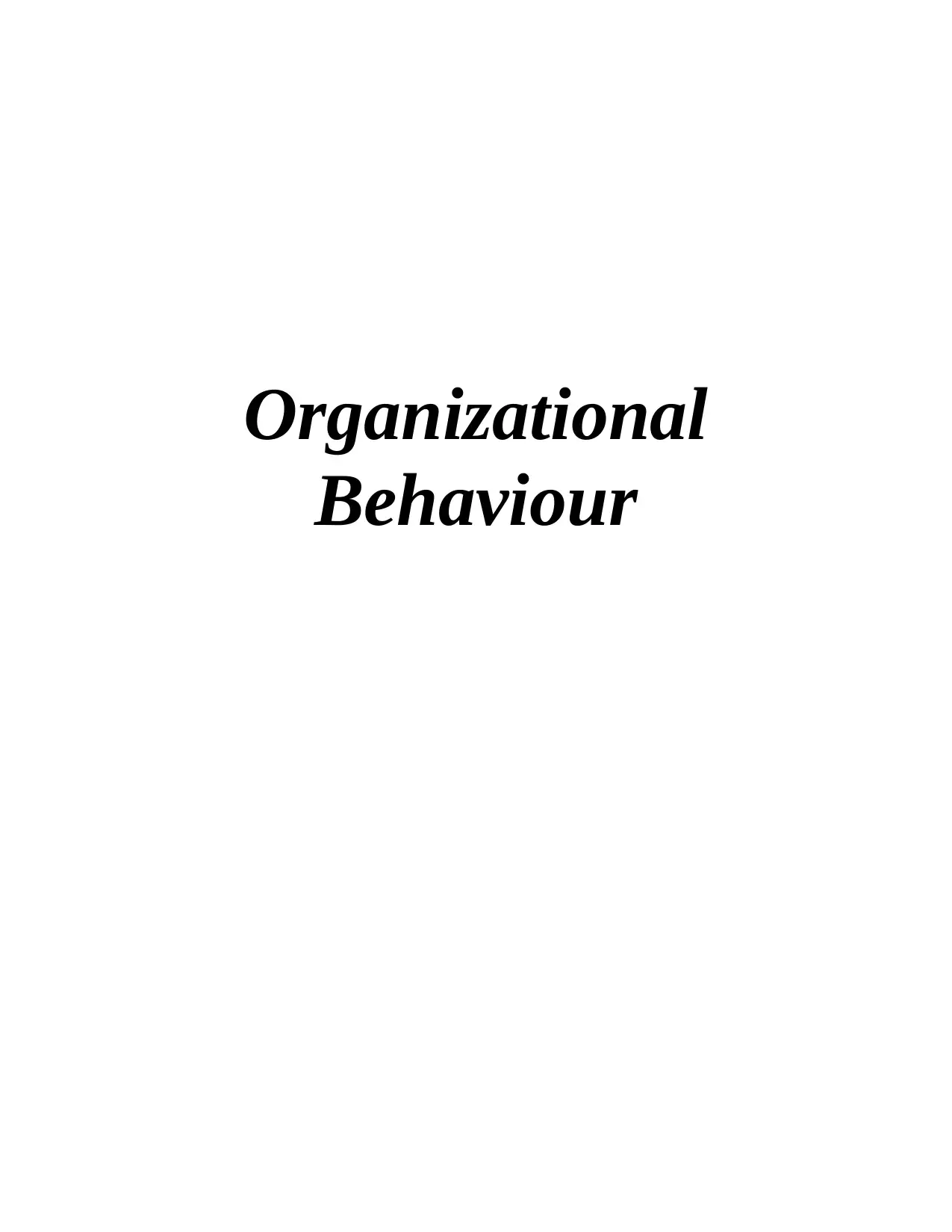
Organizational
Behaviour
Behaviour
Paraphrase This Document
Need a fresh take? Get an instant paraphrase of this document with our AI Paraphraser
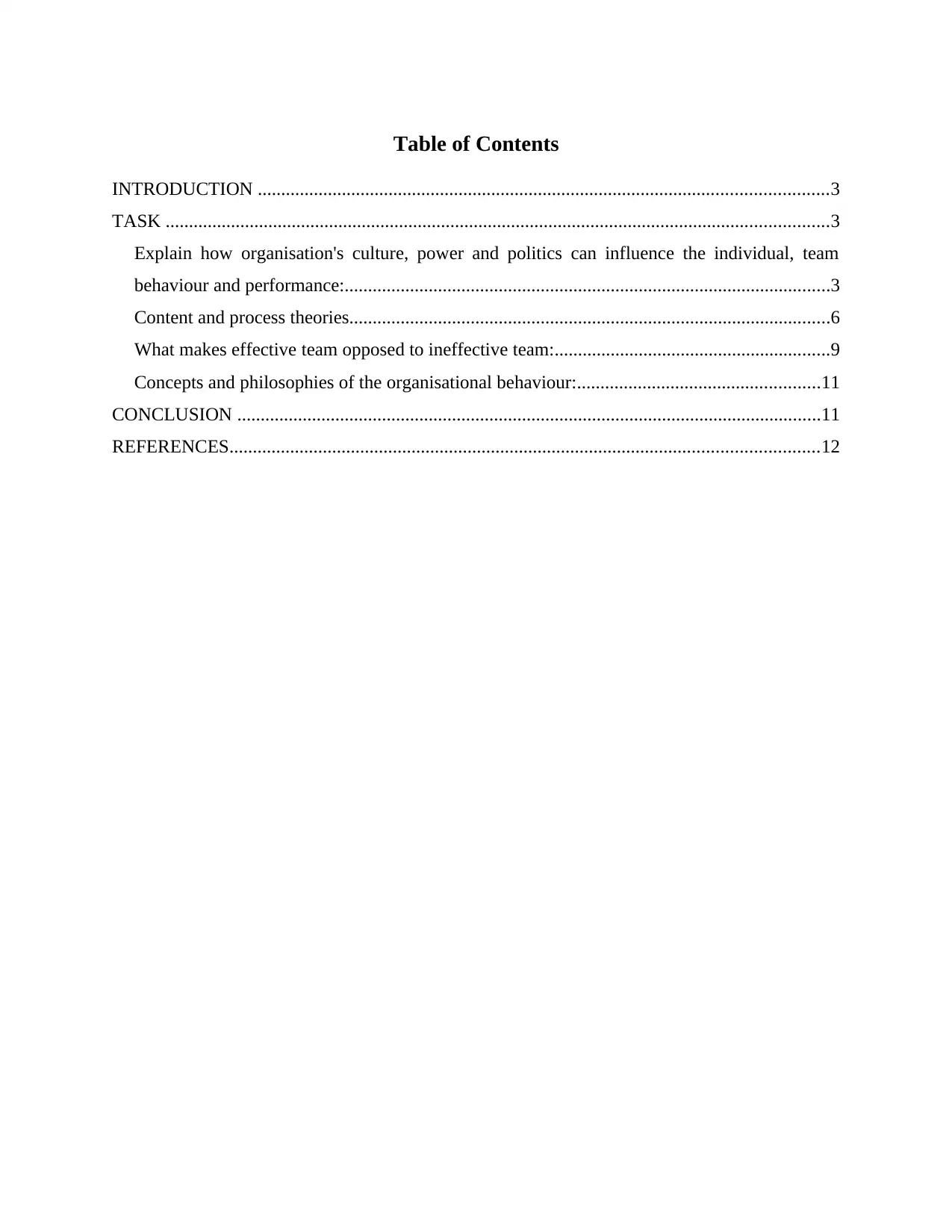
Table of Contents
INTRODUCTION ..........................................................................................................................3
TASK ..............................................................................................................................................3
Explain how organisation's culture, power and politics can influence the individual, team
behaviour and performance:........................................................................................................3
Content and process theories.......................................................................................................6
What makes effective team opposed to ineffective team:...........................................................9
Concepts and philosophies of the organisational behaviour:....................................................11
CONCLUSION .............................................................................................................................11
REFERENCES..............................................................................................................................12
INTRODUCTION ..........................................................................................................................3
TASK ..............................................................................................................................................3
Explain how organisation's culture, power and politics can influence the individual, team
behaviour and performance:........................................................................................................3
Content and process theories.......................................................................................................6
What makes effective team opposed to ineffective team:...........................................................9
Concepts and philosophies of the organisational behaviour:....................................................11
CONCLUSION .............................................................................................................................11
REFERENCES..............................................................................................................................12
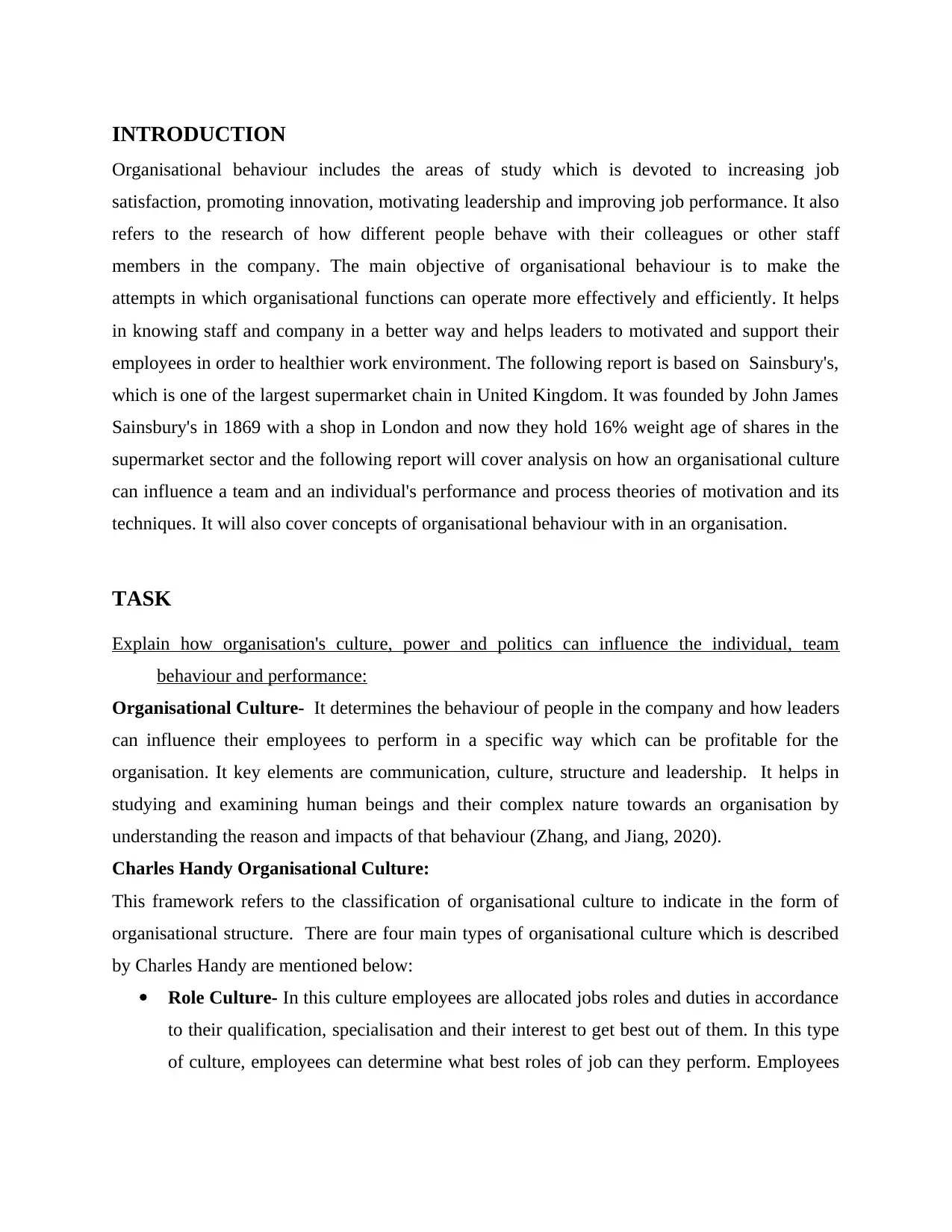
INTRODUCTION
Organisational behaviour includes the areas of study which is devoted to increasing job
satisfaction, promoting innovation, motivating leadership and improving job performance. It also
refers to the research of how different people behave with their colleagues or other staff
members in the company. The main objective of organisational behaviour is to make the
attempts in which organisational functions can operate more effectively and efficiently. It helps
in knowing staff and company in a better way and helps leaders to motivated and support their
employees in order to healthier work environment. The following report is based on Sainsbury's,
which is one of the largest supermarket chain in United Kingdom. It was founded by John James
Sainsbury's in 1869 with a shop in London and now they hold 16% weight age of shares in the
supermarket sector and the following report will cover analysis on how an organisational culture
can influence a team and an individual's performance and process theories of motivation and its
techniques. It will also cover concepts of organisational behaviour with in an organisation.
TASK
Explain how organisation's culture, power and politics can influence the individual, team
behaviour and performance:
Organisational Culture- It determines the behaviour of people in the company and how leaders
can influence their employees to perform in a specific way which can be profitable for the
organisation. It key elements are communication, culture, structure and leadership. It helps in
studying and examining human beings and their complex nature towards an organisation by
understanding the reason and impacts of that behaviour (Zhang, and Jiang, 2020).
Charles Handy Organisational Culture:
This framework refers to the classification of organisational culture to indicate in the form of
organisational structure. There are four main types of organisational culture which is described
by Charles Handy are mentioned below:
Role Culture- In this culture employees are allocated jobs roles and duties in accordance
to their qualification, specialisation and their interest to get best out of them. In this type
of culture, employees can determine what best roles of job can they perform. Employees
Organisational behaviour includes the areas of study which is devoted to increasing job
satisfaction, promoting innovation, motivating leadership and improving job performance. It also
refers to the research of how different people behave with their colleagues or other staff
members in the company. The main objective of organisational behaviour is to make the
attempts in which organisational functions can operate more effectively and efficiently. It helps
in knowing staff and company in a better way and helps leaders to motivated and support their
employees in order to healthier work environment. The following report is based on Sainsbury's,
which is one of the largest supermarket chain in United Kingdom. It was founded by John James
Sainsbury's in 1869 with a shop in London and now they hold 16% weight age of shares in the
supermarket sector and the following report will cover analysis on how an organisational culture
can influence a team and an individual's performance and process theories of motivation and its
techniques. It will also cover concepts of organisational behaviour with in an organisation.
TASK
Explain how organisation's culture, power and politics can influence the individual, team
behaviour and performance:
Organisational Culture- It determines the behaviour of people in the company and how leaders
can influence their employees to perform in a specific way which can be profitable for the
organisation. It key elements are communication, culture, structure and leadership. It helps in
studying and examining human beings and their complex nature towards an organisation by
understanding the reason and impacts of that behaviour (Zhang, and Jiang, 2020).
Charles Handy Organisational Culture:
This framework refers to the classification of organisational culture to indicate in the form of
organisational structure. There are four main types of organisational culture which is described
by Charles Handy are mentioned below:
Role Culture- In this culture employees are allocated jobs roles and duties in accordance
to their qualification, specialisation and their interest to get best out of them. In this type
of culture, employees can determine what best roles of job can they perform. Employees
⊘ This is a preview!⊘
Do you want full access?
Subscribe today to unlock all pages.

Trusted by 1+ million students worldwide
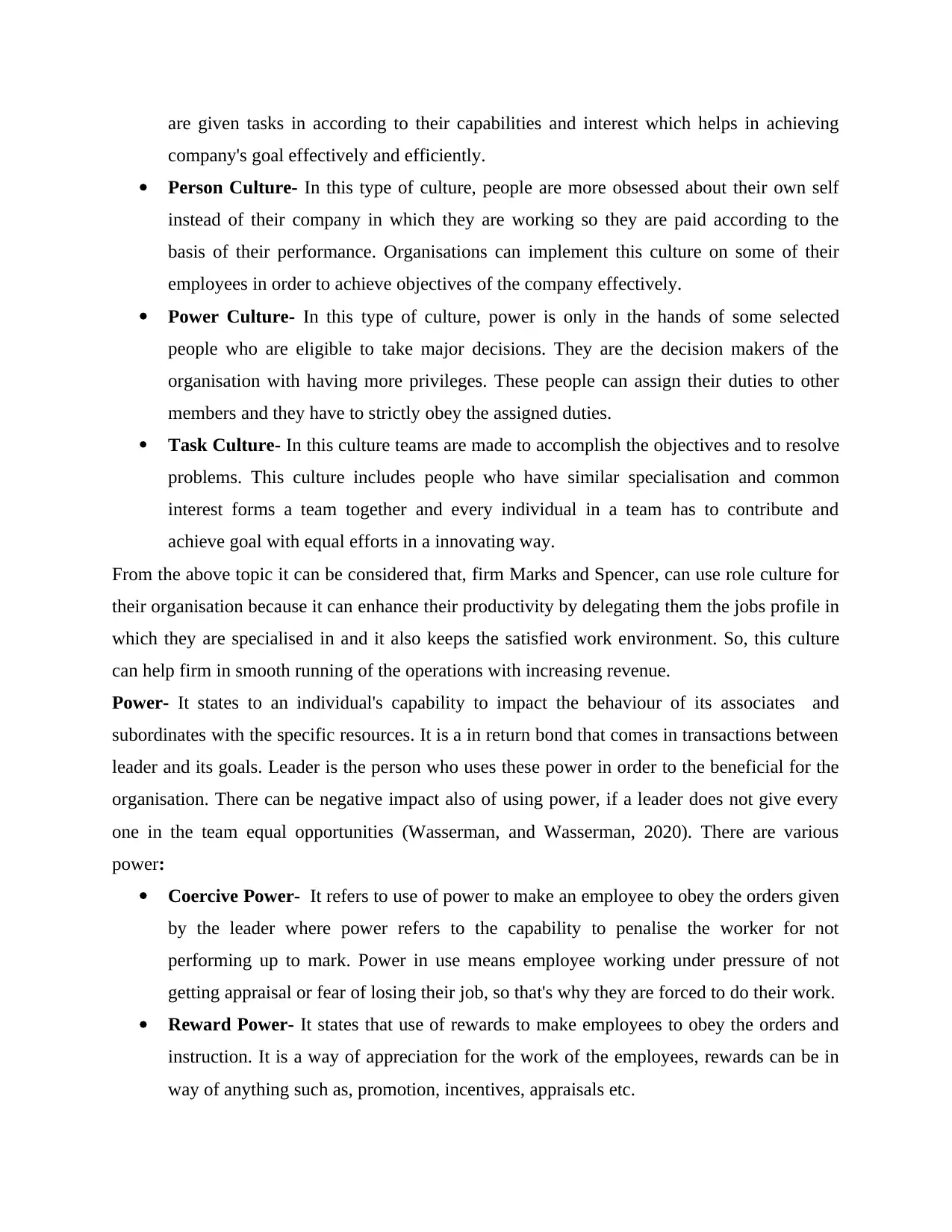
are given tasks in according to their capabilities and interest which helps in achieving
company's goal effectively and efficiently.
Person Culture- In this type of culture, people are more obsessed about their own self
instead of their company in which they are working so they are paid according to the
basis of their performance. Organisations can implement this culture on some of their
employees in order to achieve objectives of the company effectively.
Power Culture- In this type of culture, power is only in the hands of some selected
people who are eligible to take major decisions. They are the decision makers of the
organisation with having more privileges. These people can assign their duties to other
members and they have to strictly obey the assigned duties.
Task Culture- In this culture teams are made to accomplish the objectives and to resolve
problems. This culture includes people who have similar specialisation and common
interest forms a team together and every individual in a team has to contribute and
achieve goal with equal efforts in a innovating way.
From the above topic it can be considered that, firm Marks and Spencer, can use role culture for
their organisation because it can enhance their productivity by delegating them the jobs profile in
which they are specialised in and it also keeps the satisfied work environment. So, this culture
can help firm in smooth running of the operations with increasing revenue.
Power- It states to an individual's capability to impact the behaviour of its associates and
subordinates with the specific resources. It is a in return bond that comes in transactions between
leader and its goals. Leader is the person who uses these power in order to the beneficial for the
organisation. There can be negative impact also of using power, if a leader does not give every
one in the team equal opportunities (Wasserman, and Wasserman, 2020). There are various
power:
Coercive Power- It refers to use of power to make an employee to obey the orders given
by the leader where power refers to the capability to penalise the worker for not
performing up to mark. Power in use means employee working under pressure of not
getting appraisal or fear of losing their job, so that's why they are forced to do their work.
Reward Power- It states that use of rewards to make employees to obey the orders and
instruction. It is a way of appreciation for the work of the employees, rewards can be in
way of anything such as, promotion, incentives, appraisals etc.
company's goal effectively and efficiently.
Person Culture- In this type of culture, people are more obsessed about their own self
instead of their company in which they are working so they are paid according to the
basis of their performance. Organisations can implement this culture on some of their
employees in order to achieve objectives of the company effectively.
Power Culture- In this type of culture, power is only in the hands of some selected
people who are eligible to take major decisions. They are the decision makers of the
organisation with having more privileges. These people can assign their duties to other
members and they have to strictly obey the assigned duties.
Task Culture- In this culture teams are made to accomplish the objectives and to resolve
problems. This culture includes people who have similar specialisation and common
interest forms a team together and every individual in a team has to contribute and
achieve goal with equal efforts in a innovating way.
From the above topic it can be considered that, firm Marks and Spencer, can use role culture for
their organisation because it can enhance their productivity by delegating them the jobs profile in
which they are specialised in and it also keeps the satisfied work environment. So, this culture
can help firm in smooth running of the operations with increasing revenue.
Power- It states to an individual's capability to impact the behaviour of its associates and
subordinates with the specific resources. It is a in return bond that comes in transactions between
leader and its goals. Leader is the person who uses these power in order to the beneficial for the
organisation. There can be negative impact also of using power, if a leader does not give every
one in the team equal opportunities (Wasserman, and Wasserman, 2020). There are various
power:
Coercive Power- It refers to use of power to make an employee to obey the orders given
by the leader where power refers to the capability to penalise the worker for not
performing up to mark. Power in use means employee working under pressure of not
getting appraisal or fear of losing their job, so that's why they are forced to do their work.
Reward Power- It states that use of rewards to make employees to obey the orders and
instruction. It is a way of appreciation for the work of the employees, rewards can be in
way of anything such as, promotion, incentives, appraisals etc.
Paraphrase This Document
Need a fresh take? Get an instant paraphrase of this document with our AI Paraphraser
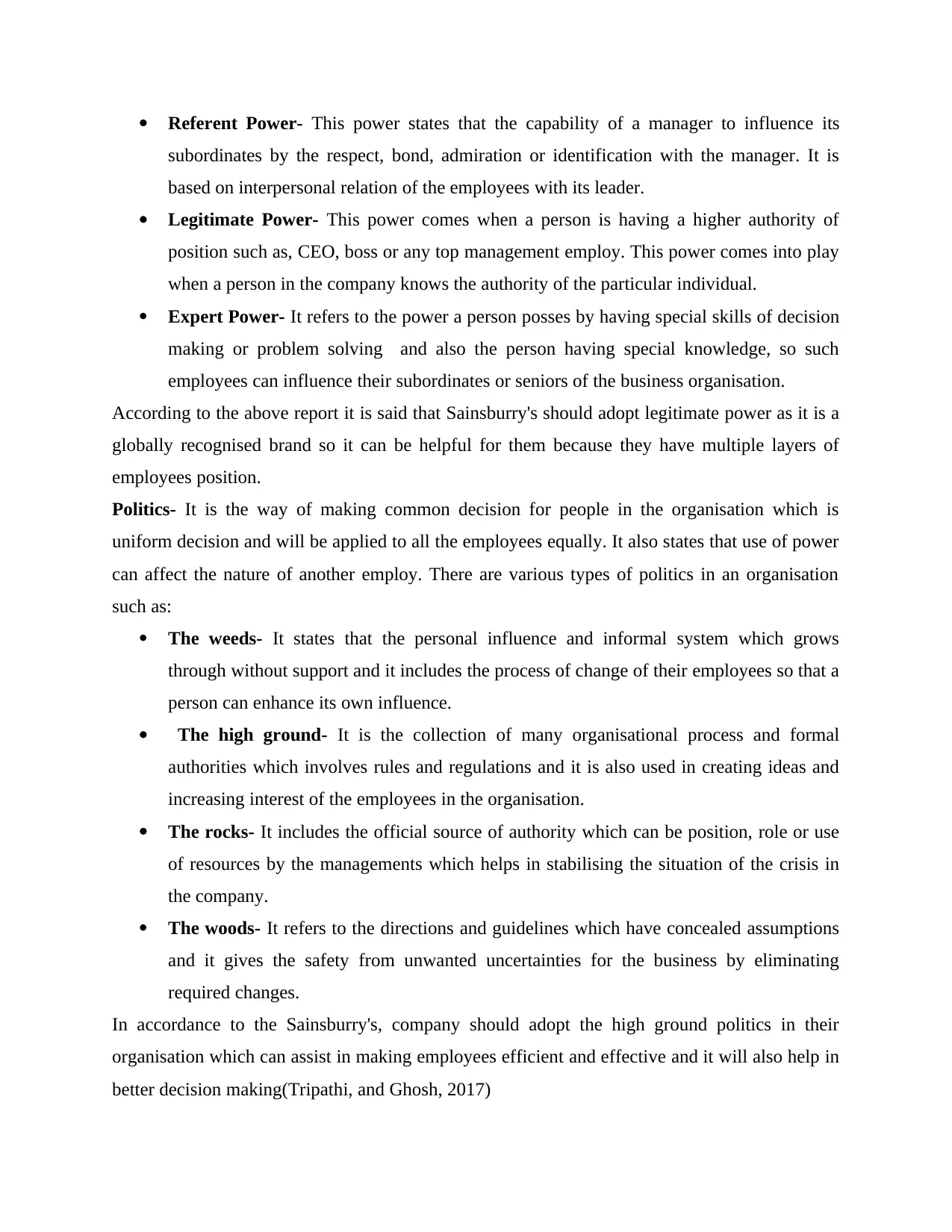
Referent Power- This power states that the capability of a manager to influence its
subordinates by the respect, bond, admiration or identification with the manager. It is
based on interpersonal relation of the employees with its leader.
Legitimate Power- This power comes when a person is having a higher authority of
position such as, CEO, boss or any top management employ. This power comes into play
when a person in the company knows the authority of the particular individual.
Expert Power- It refers to the power a person posses by having special skills of decision
making or problem solving and also the person having special knowledge, so such
employees can influence their subordinates or seniors of the business organisation.
According to the above report it is said that Sainsburry's should adopt legitimate power as it is a
globally recognised brand so it can be helpful for them because they have multiple layers of
employees position.
Politics- It is the way of making common decision for people in the organisation which is
uniform decision and will be applied to all the employees equally. It also states that use of power
can affect the nature of another employ. There are various types of politics in an organisation
such as:
The weeds- It states that the personal influence and informal system which grows
through without support and it includes the process of change of their employees so that a
person can enhance its own influence.
The high ground- It is the collection of many organisational process and formal
authorities which involves rules and regulations and it is also used in creating ideas and
increasing interest of the employees in the organisation.
The rocks- It includes the official source of authority which can be position, role or use
of resources by the managements which helps in stabilising the situation of the crisis in
the company.
The woods- It refers to the directions and guidelines which have concealed assumptions
and it gives the safety from unwanted uncertainties for the business by eliminating
required changes.
In accordance to the Sainsburry's, company should adopt the high ground politics in their
organisation which can assist in making employees efficient and effective and it will also help in
better decision making(Tripathi, and Ghosh, 2017)
subordinates by the respect, bond, admiration or identification with the manager. It is
based on interpersonal relation of the employees with its leader.
Legitimate Power- This power comes when a person is having a higher authority of
position such as, CEO, boss or any top management employ. This power comes into play
when a person in the company knows the authority of the particular individual.
Expert Power- It refers to the power a person posses by having special skills of decision
making or problem solving and also the person having special knowledge, so such
employees can influence their subordinates or seniors of the business organisation.
According to the above report it is said that Sainsburry's should adopt legitimate power as it is a
globally recognised brand so it can be helpful for them because they have multiple layers of
employees position.
Politics- It is the way of making common decision for people in the organisation which is
uniform decision and will be applied to all the employees equally. It also states that use of power
can affect the nature of another employ. There are various types of politics in an organisation
such as:
The weeds- It states that the personal influence and informal system which grows
through without support and it includes the process of change of their employees so that a
person can enhance its own influence.
The high ground- It is the collection of many organisational process and formal
authorities which involves rules and regulations and it is also used in creating ideas and
increasing interest of the employees in the organisation.
The rocks- It includes the official source of authority which can be position, role or use
of resources by the managements which helps in stabilising the situation of the crisis in
the company.
The woods- It refers to the directions and guidelines which have concealed assumptions
and it gives the safety from unwanted uncertainties for the business by eliminating
required changes.
In accordance to the Sainsburry's, company should adopt the high ground politics in their
organisation which can assist in making employees efficient and effective and it will also help in
better decision making(Tripathi, and Ghosh, 2017)
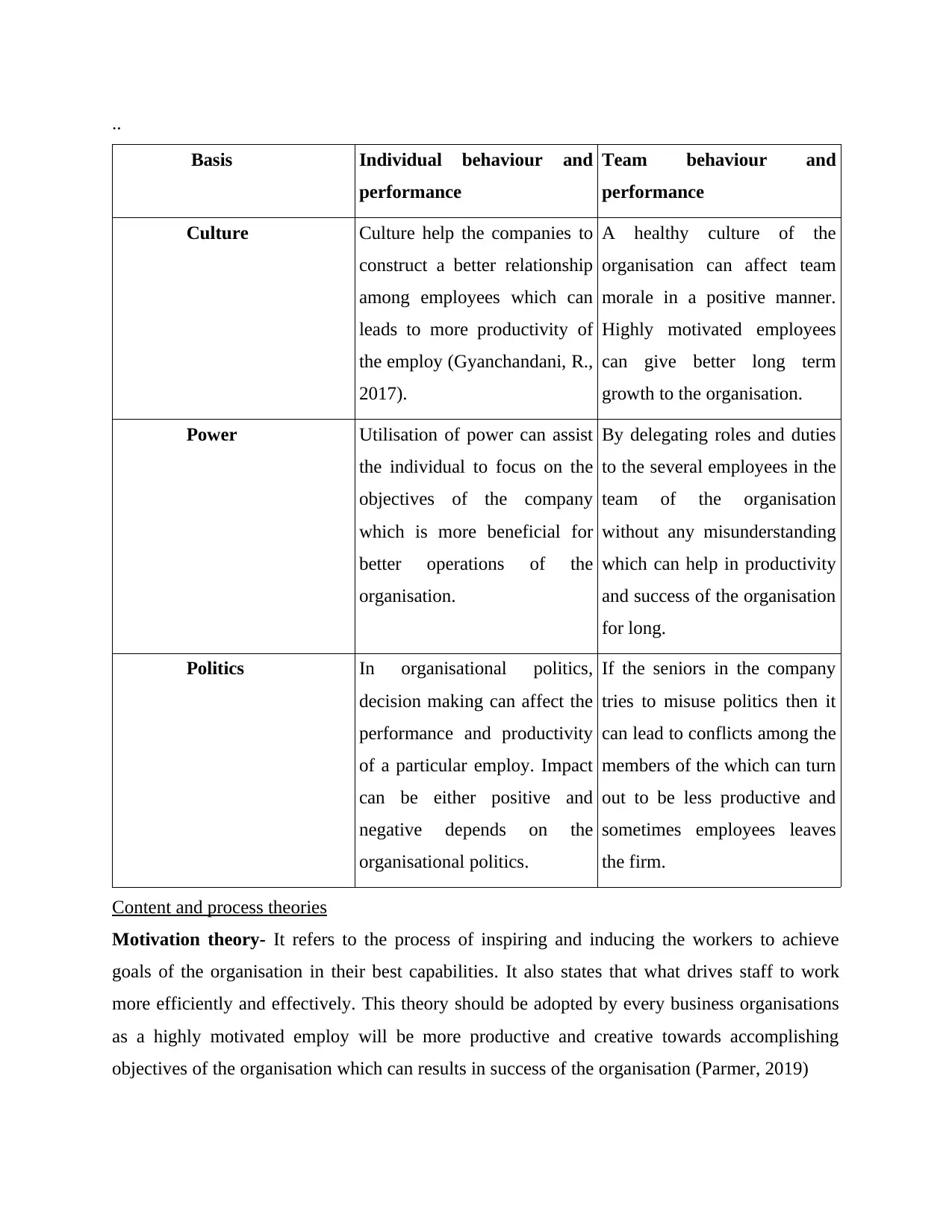
..
Basis Individual behaviour and
performance
Team behaviour and
performance
Culture Culture help the companies to
construct a better relationship
among employees which can
leads to more productivity of
the employ (Gyanchandani, R.,
2017).
A healthy culture of the
organisation can affect team
morale in a positive manner.
Highly motivated employees
can give better long term
growth to the organisation.
Power Utilisation of power can assist
the individual to focus on the
objectives of the company
which is more beneficial for
better operations of the
organisation.
By delegating roles and duties
to the several employees in the
team of the organisation
without any misunderstanding
which can help in productivity
and success of the organisation
for long.
Politics In organisational politics,
decision making can affect the
performance and productivity
of a particular employ. Impact
can be either positive and
negative depends on the
organisational politics.
If the seniors in the company
tries to misuse politics then it
can lead to conflicts among the
members of the which can turn
out to be less productive and
sometimes employees leaves
the firm.
Content and process theories
Motivation theory- It refers to the process of inspiring and inducing the workers to achieve
goals of the organisation in their best capabilities. It also states that what drives staff to work
more efficiently and effectively. This theory should be adopted by every business organisations
as a highly motivated employ will be more productive and creative towards accomplishing
objectives of the organisation which can results in success of the organisation (Parmer, 2019)
Basis Individual behaviour and
performance
Team behaviour and
performance
Culture Culture help the companies to
construct a better relationship
among employees which can
leads to more productivity of
the employ (Gyanchandani, R.,
2017).
A healthy culture of the
organisation can affect team
morale in a positive manner.
Highly motivated employees
can give better long term
growth to the organisation.
Power Utilisation of power can assist
the individual to focus on the
objectives of the company
which is more beneficial for
better operations of the
organisation.
By delegating roles and duties
to the several employees in the
team of the organisation
without any misunderstanding
which can help in productivity
and success of the organisation
for long.
Politics In organisational politics,
decision making can affect the
performance and productivity
of a particular employ. Impact
can be either positive and
negative depends on the
organisational politics.
If the seniors in the company
tries to misuse politics then it
can lead to conflicts among the
members of the which can turn
out to be less productive and
sometimes employees leaves
the firm.
Content and process theories
Motivation theory- It refers to the process of inspiring and inducing the workers to achieve
goals of the organisation in their best capabilities. It also states that what drives staff to work
more efficiently and effectively. This theory should be adopted by every business organisations
as a highly motivated employ will be more productive and creative towards accomplishing
objectives of the organisation which can results in success of the organisation (Parmer, 2019)
⊘ This is a preview!⊘
Do you want full access?
Subscribe today to unlock all pages.

Trusted by 1+ million students worldwide
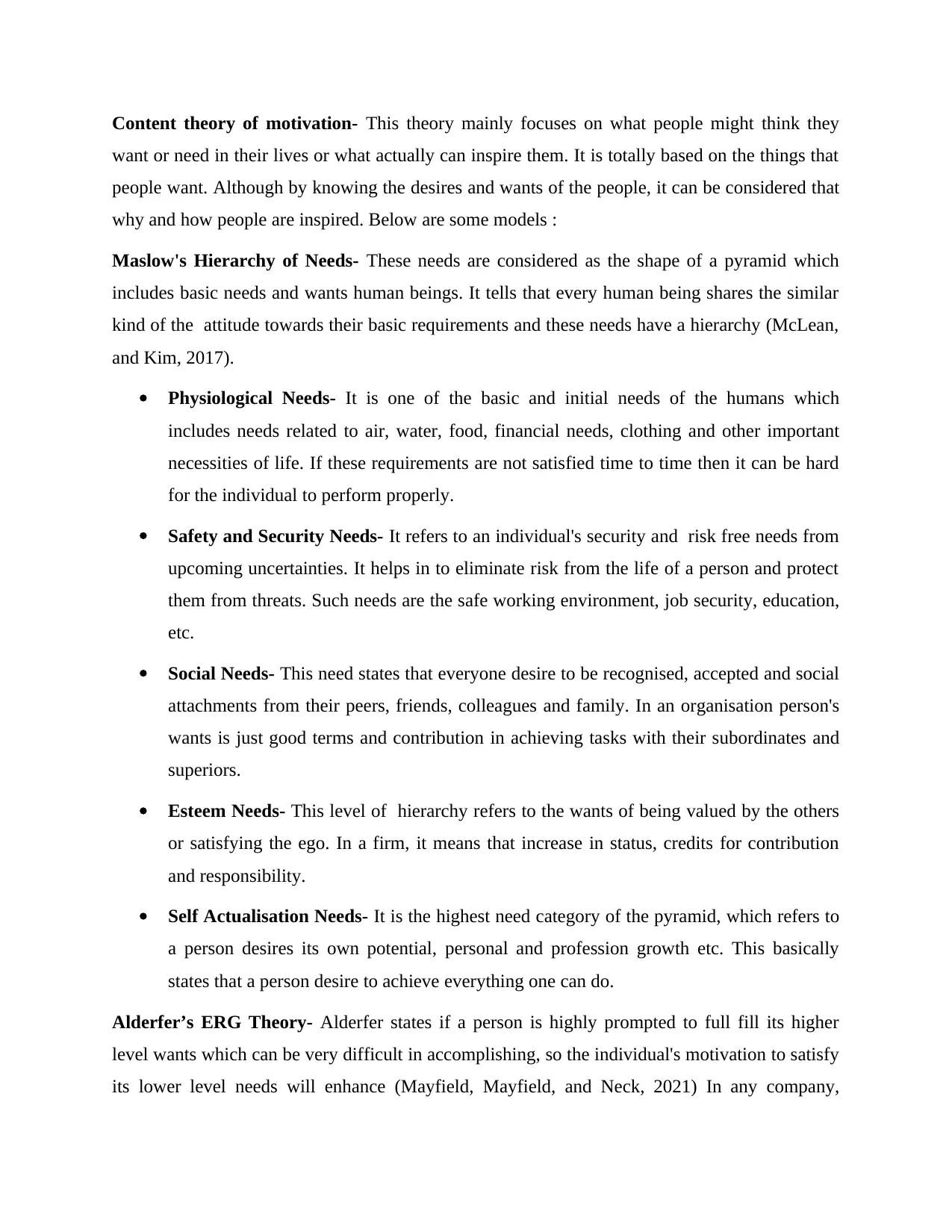
Content theory of motivation- This theory mainly focuses on what people might think they
want or need in their lives or what actually can inspire them. It is totally based on the things that
people want. Although by knowing the desires and wants of the people, it can be considered that
why and how people are inspired. Below are some models :
Maslow's Hierarchy of Needs- These needs are considered as the shape of a pyramid which
includes basic needs and wants human beings. It tells that every human being shares the similar
kind of the attitude towards their basic requirements and these needs have a hierarchy (McLean,
and Kim, 2017).
Physiological Needs- It is one of the basic and initial needs of the humans which
includes needs related to air, water, food, financial needs, clothing and other important
necessities of life. If these requirements are not satisfied time to time then it can be hard
for the individual to perform properly.
Safety and Security Needs- It refers to an individual's security and risk free needs from
upcoming uncertainties. It helps in to eliminate risk from the life of a person and protect
them from threats. Such needs are the safe working environment, job security, education,
etc.
Social Needs- This need states that everyone desire to be recognised, accepted and social
attachments from their peers, friends, colleagues and family. In an organisation person's
wants is just good terms and contribution in achieving tasks with their subordinates and
superiors.
Esteem Needs- This level of hierarchy refers to the wants of being valued by the others
or satisfying the ego. In a firm, it means that increase in status, credits for contribution
and responsibility.
Self Actualisation Needs- It is the highest need category of the pyramid, which refers to
a person desires its own potential, personal and profession growth etc. This basically
states that a person desire to achieve everything one can do.
Alderfer’s ERG Theory- Alderfer states if a person is highly prompted to full fill its higher
level wants which can be very difficult in accomplishing, so the individual's motivation to satisfy
its lower level needs will enhance (Mayfield, Mayfield, and Neck, 2021) In any company,
want or need in their lives or what actually can inspire them. It is totally based on the things that
people want. Although by knowing the desires and wants of the people, it can be considered that
why and how people are inspired. Below are some models :
Maslow's Hierarchy of Needs- These needs are considered as the shape of a pyramid which
includes basic needs and wants human beings. It tells that every human being shares the similar
kind of the attitude towards their basic requirements and these needs have a hierarchy (McLean,
and Kim, 2017).
Physiological Needs- It is one of the basic and initial needs of the humans which
includes needs related to air, water, food, financial needs, clothing and other important
necessities of life. If these requirements are not satisfied time to time then it can be hard
for the individual to perform properly.
Safety and Security Needs- It refers to an individual's security and risk free needs from
upcoming uncertainties. It helps in to eliminate risk from the life of a person and protect
them from threats. Such needs are the safe working environment, job security, education,
etc.
Social Needs- This need states that everyone desire to be recognised, accepted and social
attachments from their peers, friends, colleagues and family. In an organisation person's
wants is just good terms and contribution in achieving tasks with their subordinates and
superiors.
Esteem Needs- This level of hierarchy refers to the wants of being valued by the others
or satisfying the ego. In a firm, it means that increase in status, credits for contribution
and responsibility.
Self Actualisation Needs- It is the highest need category of the pyramid, which refers to
a person desires its own potential, personal and profession growth etc. This basically
states that a person desire to achieve everything one can do.
Alderfer’s ERG Theory- Alderfer states if a person is highly prompted to full fill its higher
level wants which can be very difficult in accomplishing, so the individual's motivation to satisfy
its lower level needs will enhance (Mayfield, Mayfield, and Neck, 2021) In any company,
Paraphrase This Document
Need a fresh take? Get an instant paraphrase of this document with our AI Paraphraser
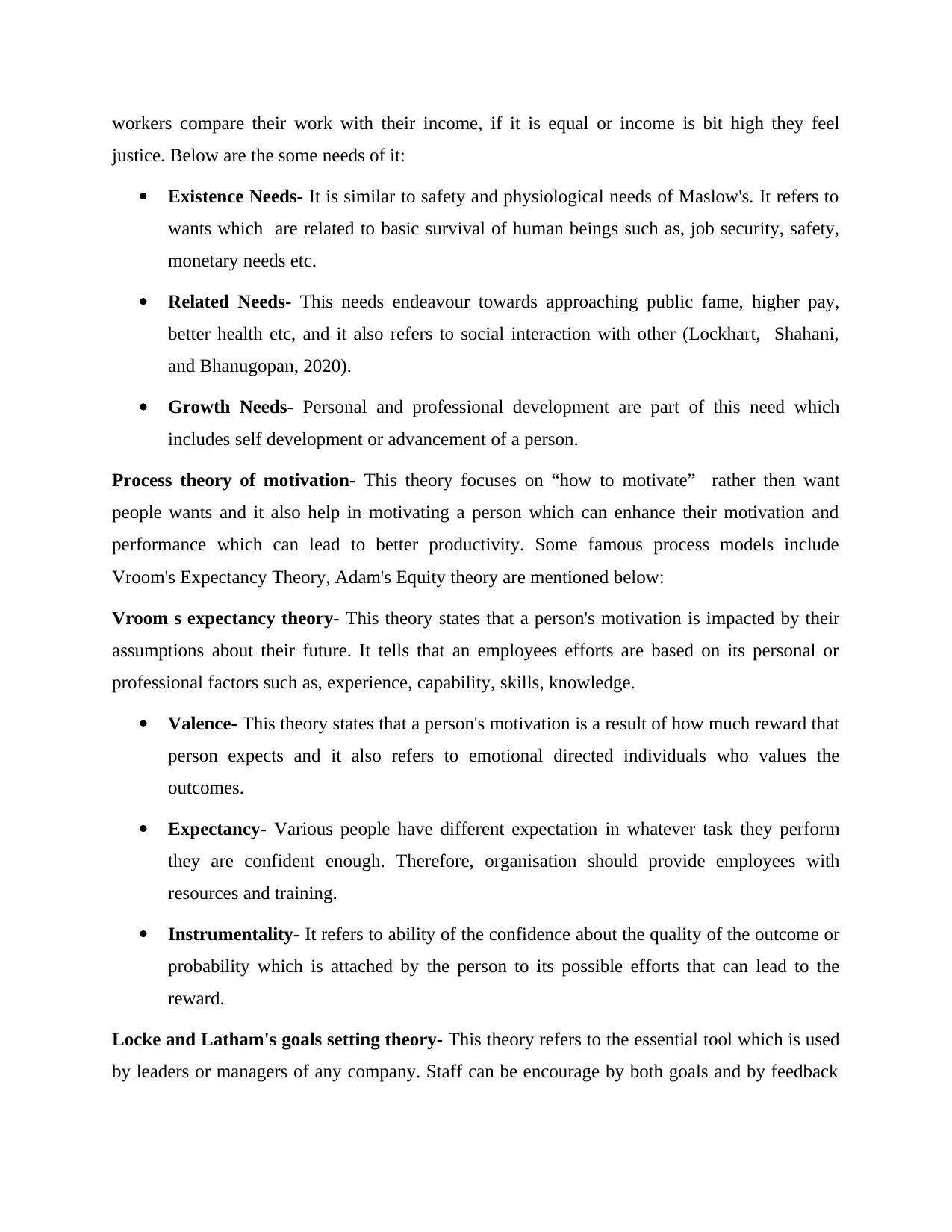
workers compare their work with their income, if it is equal or income is bit high they feel
justice. Below are the some needs of it:
Existence Needs- It is similar to safety and physiological needs of Maslow's. It refers to
wants which are related to basic survival of human beings such as, job security, safety,
monetary needs etc.
Related Needs- This needs endeavour towards approaching public fame, higher pay,
better health etc, and it also refers to social interaction with other (Lockhart, Shahani,
and Bhanugopan, 2020).
Growth Needs- Personal and professional development are part of this need which
includes self development or advancement of a person.
Process theory of motivation- This theory focuses on “how to motivate” rather then want
people wants and it also help in motivating a person which can enhance their motivation and
performance which can lead to better productivity. Some famous process models include
Vroom's Expectancy Theory, Adam's Equity theory are mentioned below:
Vroom s expectancy theory- This theory states that a person's motivation is impacted by their
assumptions about their future. It tells that an employees efforts are based on its personal or
professional factors such as, experience, capability, skills, knowledge.
Valence- This theory states that a person's motivation is a result of how much reward that
person expects and it also refers to emotional directed individuals who values the
outcomes.
Expectancy- Various people have different expectation in whatever task they perform
they are confident enough. Therefore, organisation should provide employees with
resources and training.
Instrumentality- It refers to ability of the confidence about the quality of the outcome or
probability which is attached by the person to its possible efforts that can lead to the
reward.
Locke and Latham's goals setting theory- This theory refers to the essential tool which is used
by leaders or managers of any company. Staff can be encourage by both goals and by feedback
justice. Below are the some needs of it:
Existence Needs- It is similar to safety and physiological needs of Maslow's. It refers to
wants which are related to basic survival of human beings such as, job security, safety,
monetary needs etc.
Related Needs- This needs endeavour towards approaching public fame, higher pay,
better health etc, and it also refers to social interaction with other (Lockhart, Shahani,
and Bhanugopan, 2020).
Growth Needs- Personal and professional development are part of this need which
includes self development or advancement of a person.
Process theory of motivation- This theory focuses on “how to motivate” rather then want
people wants and it also help in motivating a person which can enhance their motivation and
performance which can lead to better productivity. Some famous process models include
Vroom's Expectancy Theory, Adam's Equity theory are mentioned below:
Vroom s expectancy theory- This theory states that a person's motivation is impacted by their
assumptions about their future. It tells that an employees efforts are based on its personal or
professional factors such as, experience, capability, skills, knowledge.
Valence- This theory states that a person's motivation is a result of how much reward that
person expects and it also refers to emotional directed individuals who values the
outcomes.
Expectancy- Various people have different expectation in whatever task they perform
they are confident enough. Therefore, organisation should provide employees with
resources and training.
Instrumentality- It refers to ability of the confidence about the quality of the outcome or
probability which is attached by the person to its possible efforts that can lead to the
reward.
Locke and Latham's goals setting theory- This theory refers to the essential tool which is used
by leaders or managers of any company. Staff can be encourage by both goals and by feedback
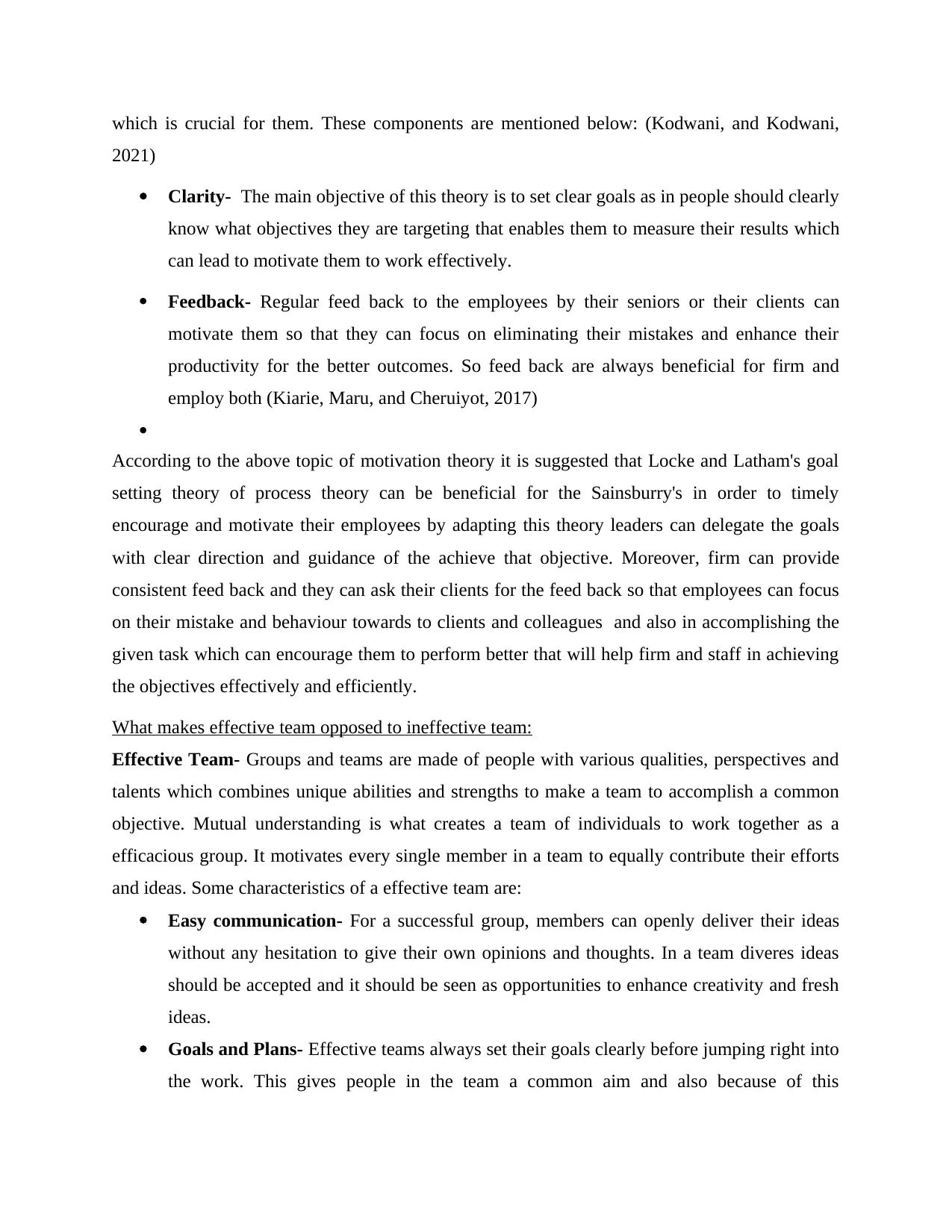
which is crucial for them. These components are mentioned below: (Kodwani, and Kodwani,
2021)
Clarity- The main objective of this theory is to set clear goals as in people should clearly
know what objectives they are targeting that enables them to measure their results which
can lead to motivate them to work effectively.
Feedback- Regular feed back to the employees by their seniors or their clients can
motivate them so that they can focus on eliminating their mistakes and enhance their
productivity for the better outcomes. So feed back are always beneficial for firm and
employ both (Kiarie, Maru, and Cheruiyot, 2017)
According to the above topic of motivation theory it is suggested that Locke and Latham's goal
setting theory of process theory can be beneficial for the Sainsburry's in order to timely
encourage and motivate their employees by adapting this theory leaders can delegate the goals
with clear direction and guidance of the achieve that objective. Moreover, firm can provide
consistent feed back and they can ask their clients for the feed back so that employees can focus
on their mistake and behaviour towards to clients and colleagues and also in accomplishing the
given task which can encourage them to perform better that will help firm and staff in achieving
the objectives effectively and efficiently.
What makes effective team opposed to ineffective team:
Effective Team- Groups and teams are made of people with various qualities, perspectives and
talents which combines unique abilities and strengths to make a team to accomplish a common
objective. Mutual understanding is what creates a team of individuals to work together as a
efficacious group. It motivates every single member in a team to equally contribute their efforts
and ideas. Some characteristics of a effective team are:
Easy communication- For a successful group, members can openly deliver their ideas
without any hesitation to give their own opinions and thoughts. In a team diveres ideas
should be accepted and it should be seen as opportunities to enhance creativity and fresh
ideas.
Goals and Plans- Effective teams always set their goals clearly before jumping right into
the work. This gives people in the team a common aim and also because of this
2021)
Clarity- The main objective of this theory is to set clear goals as in people should clearly
know what objectives they are targeting that enables them to measure their results which
can lead to motivate them to work effectively.
Feedback- Regular feed back to the employees by their seniors or their clients can
motivate them so that they can focus on eliminating their mistakes and enhance their
productivity for the better outcomes. So feed back are always beneficial for firm and
employ both (Kiarie, Maru, and Cheruiyot, 2017)
According to the above topic of motivation theory it is suggested that Locke and Latham's goal
setting theory of process theory can be beneficial for the Sainsburry's in order to timely
encourage and motivate their employees by adapting this theory leaders can delegate the goals
with clear direction and guidance of the achieve that objective. Moreover, firm can provide
consistent feed back and they can ask their clients for the feed back so that employees can focus
on their mistake and behaviour towards to clients and colleagues and also in accomplishing the
given task which can encourage them to perform better that will help firm and staff in achieving
the objectives effectively and efficiently.
What makes effective team opposed to ineffective team:
Effective Team- Groups and teams are made of people with various qualities, perspectives and
talents which combines unique abilities and strengths to make a team to accomplish a common
objective. Mutual understanding is what creates a team of individuals to work together as a
efficacious group. It motivates every single member in a team to equally contribute their efforts
and ideas. Some characteristics of a effective team are:
Easy communication- For a successful group, members can openly deliver their ideas
without any hesitation to give their own opinions and thoughts. In a team diveres ideas
should be accepted and it should be seen as opportunities to enhance creativity and fresh
ideas.
Goals and Plans- Effective teams always set their goals clearly before jumping right into
the work. This gives people in the team a common aim and also because of this
⊘ This is a preview!⊘
Do you want full access?
Subscribe today to unlock all pages.

Trusted by 1+ million students worldwide
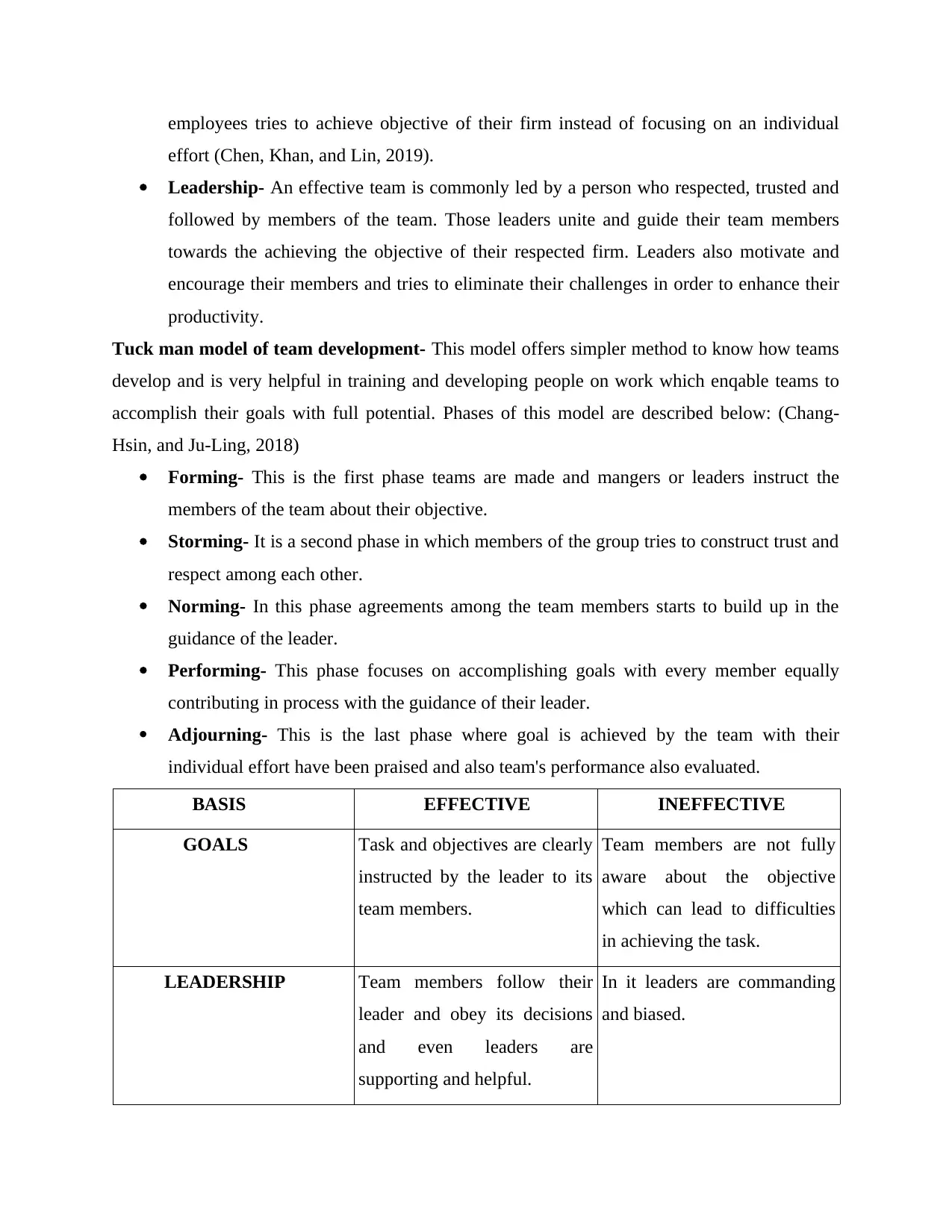
employees tries to achieve objective of their firm instead of focusing on an individual
effort (Chen, Khan, and Lin, 2019).
Leadership- An effective team is commonly led by a person who respected, trusted and
followed by members of the team. Those leaders unite and guide their team members
towards the achieving the objective of their respected firm. Leaders also motivate and
encourage their members and tries to eliminate their challenges in order to enhance their
productivity.
Tuck man model of team development- This model offers simpler method to know how teams
develop and is very helpful in training and developing people on work which enqable teams to
accomplish their goals with full potential. Phases of this model are described below: (Chang-
Hsin, and Ju-Ling, 2018)
Forming- This is the first phase teams are made and mangers or leaders instruct the
members of the team about their objective.
Storming- It is a second phase in which members of the group tries to construct trust and
respect among each other.
Norming- In this phase agreements among the team members starts to build up in the
guidance of the leader.
Performing- This phase focuses on accomplishing goals with every member equally
contributing in process with the guidance of their leader.
Adjourning- This is the last phase where goal is achieved by the team with their
individual effort have been praised and also team's performance also evaluated.
BASIS EFFECTIVE INEFFECTIVE
GOALS Task and objectives are clearly
instructed by the leader to its
team members.
Team members are not fully
aware about the objective
which can lead to difficulties
in achieving the task.
LEADERSHIP Team members follow their
leader and obey its decisions
and even leaders are
supporting and helpful.
In it leaders are commanding
and biased.
effort (Chen, Khan, and Lin, 2019).
Leadership- An effective team is commonly led by a person who respected, trusted and
followed by members of the team. Those leaders unite and guide their team members
towards the achieving the objective of their respected firm. Leaders also motivate and
encourage their members and tries to eliminate their challenges in order to enhance their
productivity.
Tuck man model of team development- This model offers simpler method to know how teams
develop and is very helpful in training and developing people on work which enqable teams to
accomplish their goals with full potential. Phases of this model are described below: (Chang-
Hsin, and Ju-Ling, 2018)
Forming- This is the first phase teams are made and mangers or leaders instruct the
members of the team about their objective.
Storming- It is a second phase in which members of the group tries to construct trust and
respect among each other.
Norming- In this phase agreements among the team members starts to build up in the
guidance of the leader.
Performing- This phase focuses on accomplishing goals with every member equally
contributing in process with the guidance of their leader.
Adjourning- This is the last phase where goal is achieved by the team with their
individual effort have been praised and also team's performance also evaluated.
BASIS EFFECTIVE INEFFECTIVE
GOALS Task and objectives are clearly
instructed by the leader to its
team members.
Team members are not fully
aware about the objective
which can lead to difficulties
in achieving the task.
LEADERSHIP Team members follow their
leader and obey its decisions
and even leaders are
supporting and helpful.
In it leaders are commanding
and biased.
Paraphrase This Document
Need a fresh take? Get an instant paraphrase of this document with our AI Paraphraser
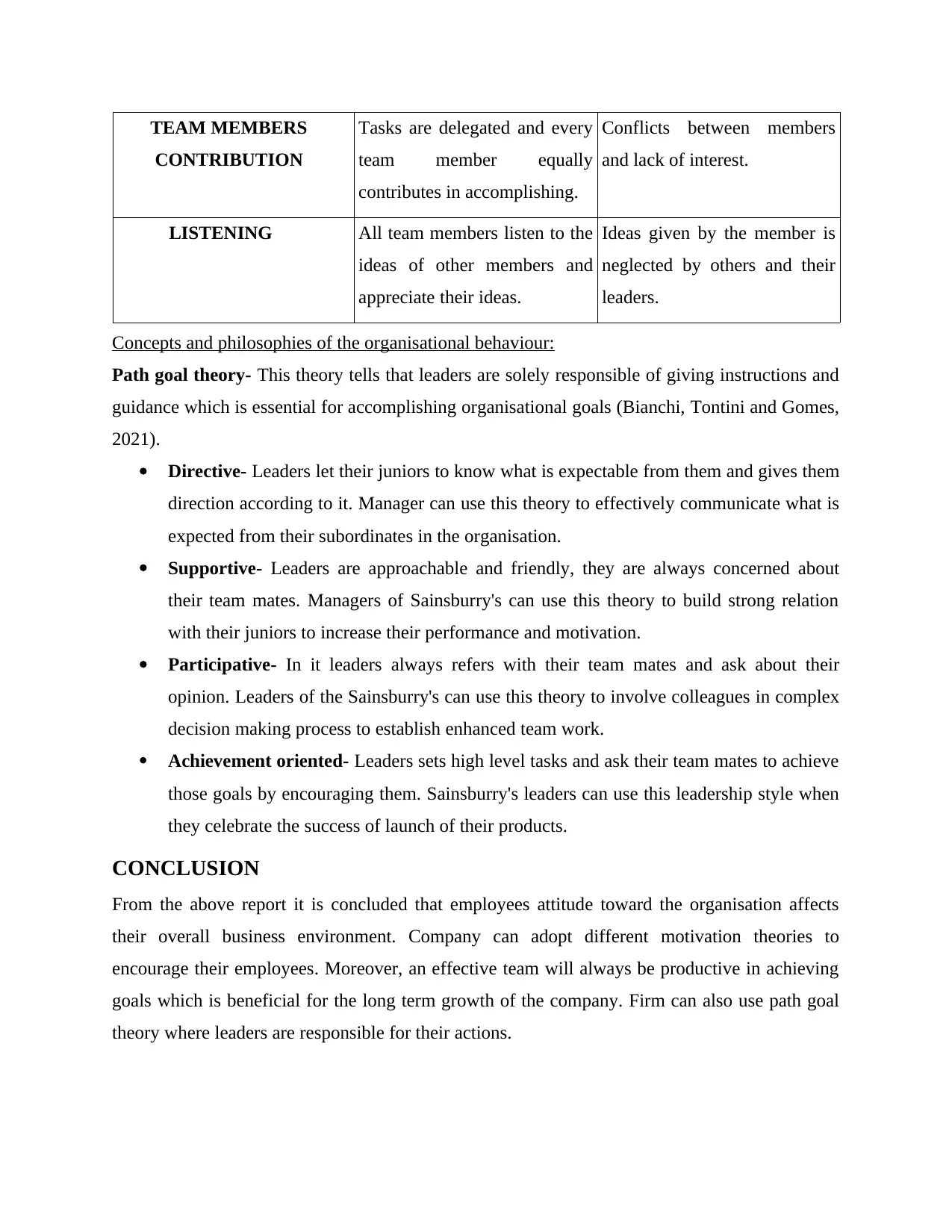
TEAM MEMBERS
CONTRIBUTION
Tasks are delegated and every
team member equally
contributes in accomplishing.
Conflicts between members
and lack of interest.
LISTENING All team members listen to the
ideas of other members and
appreciate their ideas.
Ideas given by the member is
neglected by others and their
leaders.
Concepts and philosophies of the organisational behaviour:
Path goal theory- This theory tells that leaders are solely responsible of giving instructions and
guidance which is essential for accomplishing organisational goals (Bianchi, Tontini and Gomes,
2021).
Directive- Leaders let their juniors to know what is expectable from them and gives them
direction according to it. Manager can use this theory to effectively communicate what is
expected from their subordinates in the organisation.
Supportive- Leaders are approachable and friendly, they are always concerned about
their team mates. Managers of Sainsburry's can use this theory to build strong relation
with their juniors to increase their performance and motivation.
Participative- In it leaders always refers with their team mates and ask about their
opinion. Leaders of the Sainsburry's can use this theory to involve colleagues in complex
decision making process to establish enhanced team work.
Achievement oriented- Leaders sets high level tasks and ask their team mates to achieve
those goals by encouraging them. Sainsburry's leaders can use this leadership style when
they celebrate the success of launch of their products.
CONCLUSION
From the above report it is concluded that employees attitude toward the organisation affects
their overall business environment. Company can adopt different motivation theories to
encourage their employees. Moreover, an effective team will always be productive in achieving
goals which is beneficial for the long term growth of the company. Firm can also use path goal
theory where leaders are responsible for their actions.
CONTRIBUTION
Tasks are delegated and every
team member equally
contributes in accomplishing.
Conflicts between members
and lack of interest.
LISTENING All team members listen to the
ideas of other members and
appreciate their ideas.
Ideas given by the member is
neglected by others and their
leaders.
Concepts and philosophies of the organisational behaviour:
Path goal theory- This theory tells that leaders are solely responsible of giving instructions and
guidance which is essential for accomplishing organisational goals (Bianchi, Tontini and Gomes,
2021).
Directive- Leaders let their juniors to know what is expectable from them and gives them
direction according to it. Manager can use this theory to effectively communicate what is
expected from their subordinates in the organisation.
Supportive- Leaders are approachable and friendly, they are always concerned about
their team mates. Managers of Sainsburry's can use this theory to build strong relation
with their juniors to increase their performance and motivation.
Participative- In it leaders always refers with their team mates and ask about their
opinion. Leaders of the Sainsburry's can use this theory to involve colleagues in complex
decision making process to establish enhanced team work.
Achievement oriented- Leaders sets high level tasks and ask their team mates to achieve
those goals by encouraging them. Sainsburry's leaders can use this leadership style when
they celebrate the success of launch of their products.
CONCLUSION
From the above report it is concluded that employees attitude toward the organisation affects
their overall business environment. Company can adopt different motivation theories to
encourage their employees. Moreover, an effective team will always be productive in achieving
goals which is beneficial for the long term growth of the company. Firm can also use path goal
theory where leaders are responsible for their actions.
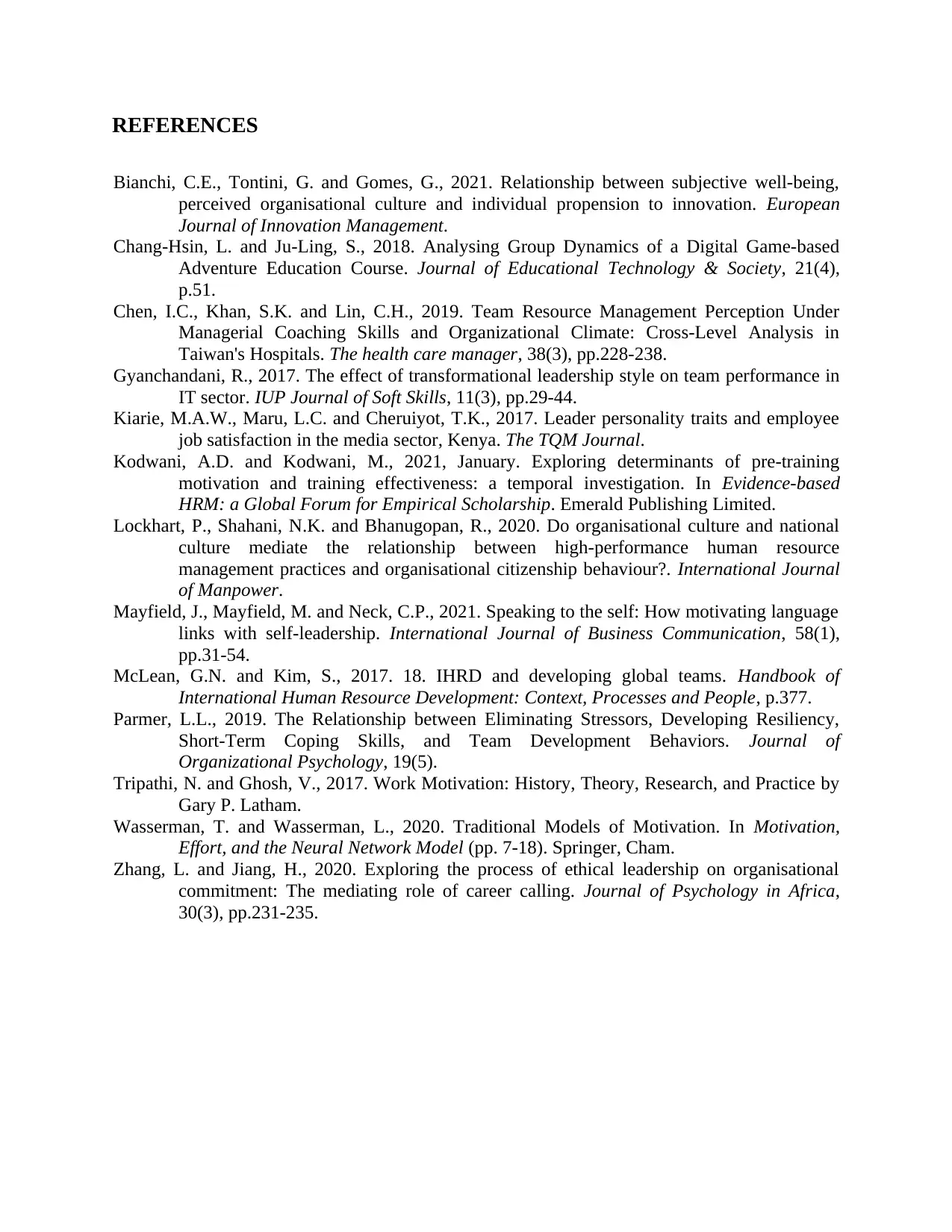
REFERENCES
Bianchi, C.E., Tontini, G. and Gomes, G., 2021. Relationship between subjective well-being,
perceived organisational culture and individual propension to innovation. European
Journal of Innovation Management.
Chang-Hsin, L. and Ju-Ling, S., 2018. Analysing Group Dynamics of a Digital Game-based
Adventure Education Course. Journal of Educational Technology & Society, 21(4),
p.51.
Chen, I.C., Khan, S.K. and Lin, C.H., 2019. Team Resource Management Perception Under
Managerial Coaching Skills and Organizational Climate: Cross-Level Analysis in
Taiwan's Hospitals. The health care manager, 38(3), pp.228-238.
Gyanchandani, R., 2017. The effect of transformational leadership style on team performance in
IT sector. IUP Journal of Soft Skills, 11(3), pp.29-44.
Kiarie, M.A.W., Maru, L.C. and Cheruiyot, T.K., 2017. Leader personality traits and employee
job satisfaction in the media sector, Kenya. The TQM Journal.
Kodwani, A.D. and Kodwani, M., 2021, January. Exploring determinants of pre-training
motivation and training effectiveness: a temporal investigation. In Evidence-based
HRM: a Global Forum for Empirical Scholarship. Emerald Publishing Limited.
Lockhart, P., Shahani, N.K. and Bhanugopan, R., 2020. Do organisational culture and national
culture mediate the relationship between high-performance human resource
management practices and organisational citizenship behaviour?. International Journal
of Manpower.
Mayfield, J., Mayfield, M. and Neck, C.P., 2021. Speaking to the self: How motivating language
links with self-leadership. International Journal of Business Communication, 58(1),
pp.31-54.
McLean, G.N. and Kim, S., 2017. 18. IHRD and developing global teams. Handbook of
International Human Resource Development: Context, Processes and People, p.377.
Parmer, L.L., 2019. The Relationship between Eliminating Stressors, Developing Resiliency,
Short-Term Coping Skills, and Team Development Behaviors. Journal of
Organizational Psychology, 19(5).
Tripathi, N. and Ghosh, V., 2017. Work Motivation: History, Theory, Research, and Practice by
Gary P. Latham.
Wasserman, T. and Wasserman, L., 2020. Traditional Models of Motivation. In Motivation,
Effort, and the Neural Network Model (pp. 7-18). Springer, Cham.
Zhang, L. and Jiang, H., 2020. Exploring the process of ethical leadership on organisational
commitment: The mediating role of career calling. Journal of Psychology in Africa,
30(3), pp.231-235.
Bianchi, C.E., Tontini, G. and Gomes, G., 2021. Relationship between subjective well-being,
perceived organisational culture and individual propension to innovation. European
Journal of Innovation Management.
Chang-Hsin, L. and Ju-Ling, S., 2018. Analysing Group Dynamics of a Digital Game-based
Adventure Education Course. Journal of Educational Technology & Society, 21(4),
p.51.
Chen, I.C., Khan, S.K. and Lin, C.H., 2019. Team Resource Management Perception Under
Managerial Coaching Skills and Organizational Climate: Cross-Level Analysis in
Taiwan's Hospitals. The health care manager, 38(3), pp.228-238.
Gyanchandani, R., 2017. The effect of transformational leadership style on team performance in
IT sector. IUP Journal of Soft Skills, 11(3), pp.29-44.
Kiarie, M.A.W., Maru, L.C. and Cheruiyot, T.K., 2017. Leader personality traits and employee
job satisfaction in the media sector, Kenya. The TQM Journal.
Kodwani, A.D. and Kodwani, M., 2021, January. Exploring determinants of pre-training
motivation and training effectiveness: a temporal investigation. In Evidence-based
HRM: a Global Forum for Empirical Scholarship. Emerald Publishing Limited.
Lockhart, P., Shahani, N.K. and Bhanugopan, R., 2020. Do organisational culture and national
culture mediate the relationship between high-performance human resource
management practices and organisational citizenship behaviour?. International Journal
of Manpower.
Mayfield, J., Mayfield, M. and Neck, C.P., 2021. Speaking to the self: How motivating language
links with self-leadership. International Journal of Business Communication, 58(1),
pp.31-54.
McLean, G.N. and Kim, S., 2017. 18. IHRD and developing global teams. Handbook of
International Human Resource Development: Context, Processes and People, p.377.
Parmer, L.L., 2019. The Relationship between Eliminating Stressors, Developing Resiliency,
Short-Term Coping Skills, and Team Development Behaviors. Journal of
Organizational Psychology, 19(5).
Tripathi, N. and Ghosh, V., 2017. Work Motivation: History, Theory, Research, and Practice by
Gary P. Latham.
Wasserman, T. and Wasserman, L., 2020. Traditional Models of Motivation. In Motivation,
Effort, and the Neural Network Model (pp. 7-18). Springer, Cham.
Zhang, L. and Jiang, H., 2020. Exploring the process of ethical leadership on organisational
commitment: The mediating role of career calling. Journal of Psychology in Africa,
30(3), pp.231-235.
⊘ This is a preview!⊘
Do you want full access?
Subscribe today to unlock all pages.

Trusted by 1+ million students worldwide
1 out of 12
Related Documents
Your All-in-One AI-Powered Toolkit for Academic Success.
+13062052269
info@desklib.com
Available 24*7 on WhatsApp / Email
![[object Object]](/_next/static/media/star-bottom.7253800d.svg)
Unlock your academic potential
Copyright © 2020–2025 A2Z Services. All Rights Reserved. Developed and managed by ZUCOL.



